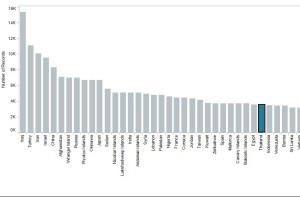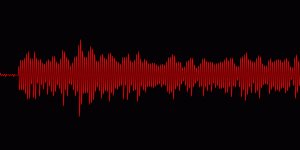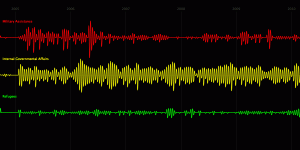thaicables – It's Your Right to know the Truth!
http://thaicables.wordpress.com/
Truth Exposed
with 2 comments
Thai government is censoring at the moment over 300.000 websites in order to prevent it's citizens free access to information. Wikileaks had been blockedon orders from Thai government under the 2005 emergency decree on as it is considered a “threat to National security” (http://goo.gl/BFcq6) With the release of approximately 3000 cables originating from the US Embassy in Bangkok which have been sent mostly from 2005 until February 2010 it is just a question of time before MICT will block the access to Wikileaks published cables (http://cablegate.wikileaks.org/) We do not believe in censorship and think that everyone in Thailand should get access to any information available on the internet, which also includes Wikileaks. This is the reason for this blog. A total of 2985 (other sources state 3516) Cables sent from the US Embassy in Bangkok will be published. While between 1989 and end of 2004 only 7 Cables will be leaked, the number increases 2005 immensely. Until end of February 2010 an average of approx. 580 Cables are sent a year which means 1 to 2 Cables a day.15 Cables have been classified as "Secret - Not for Foreign Eyes" 60 Cables are labeled "Secret" and 17 "Confidential - Not for Foreign Eyes". The huge majority, 1326 are "Confidential", and 536 "Unclassified , for official use only", leaving 987 Cables marked "Unclassified". Approximately 50 % of those Cables could contain sensitive information guessing from their security classification.
Thanks to xxxx a decoding of what the Thai Cables contain is available. They cover a wide range of topics from Arms Controls and Disarment to Refugees and Human Rights Issues, Democratization, Human Trafficking, Nuclear Issues, Terrorism and Military Operations, Foreign Trade, Internal Government Affairs, Relations between Saudi Arabia and Thailand, Foreign Investments, Intellectual Property Rights and even Thai Prime Minister and Thai Rak Thai. Even Cables talking about War Crimes, Thai Elections, Intelligence, Corruption, Political Parties will be published. Detailed Overview of Thai Cables to be leaked (pdf download) A lot of explosive information can be expected.
A fantastic search index about released Cables can be found here:Source: New Mandala http://goo.gl/BgNJU 2/10/2010Leaking evidence of violence and machinations in Thailand
December 2nd, 2010 by Tyrell Haberkorn, Guest Contributor
On 28 November 2010, the release of U.S. diplomatic cables by WikiLeaks, the insurgentcitizen watchdog group headed by the elusive Julian Assange sent shockwaves throughoutthe ranks of the U.S. government and its allies. The released cables, which date from1966 to the present, have suggested collusion between the ostensibly democratic U.S.regime and less savory regimes around the world, pointed to spying by members of theU.S. diplomatic corps, and raised significant questions about the objectives of U.S.foreign policy. WikiLeaks’ latest release has also prompted an outpouring of panicby the U.S. government about the effects of the cables on their legitimacy and workand conflicting responses by human rights groups that the released cables may containunredacted information which may further endanger those who are already vulnerable.At this stage, only a very small number of the documents have been released. WikiLeaksthemselves have posted 291 out of 251,287 total documents, while a handful of newsand El Pais — have also published either extracts of documents or analysis based on them.Although the published cables and analyses have covered a range of significant issues,there is one location, often overlooked in discussions of U.S. foreign policy, whichhas not yet emerged in the available cables.This location is Thailand. Thailand has long been an important diplomatic ally of theUnited States as well as a willing host to overt and clandestine U.S. operations beginningwith the Cold War and continuing through to the so-called War on Terror. Both the numberof documents which mention Thailand and the number which originated the U.S. Embassy inBangkok are in the highest fifth of all documents on WikiLeaks. In concrete terms, this meansthat there are 3,516 cables which mention Thailand, and 2,941 which originated at the embassyin Bangkok (75 classified as ‘secret,’ 1343 classified as ‘confidential,’ and 1523 that were‘unclassified’).While we wait for the cables related to Thailand to be released, it is worthwhile to ponderpotential lacunae which might be cleared up by information contained within them. Accordingto Der Spiegel, leaked cables which originated in Bangkok only date from 2004 but the 3,516documents which mention Thailand may cover a wider period. The information contained inthe documents which mention Thailand is potentially significant not only in relation to theU.S. role in Thailand, but also in terms of basic information about events in Thailand. Inthe context of relatively un-free circulation of information in Thailand, particularly aboutpast episodes of state violence or anything else which could be argued to be related to‘national security,’ the diplomatic cables may contain very significant revelations.While the list of topics covered by the cables is now available, as mentioned by Bangkok Pundit,the categories are not yet specific enough to pinpoint what may or may not be addressed.Despite this uncertainty, I raise two topics which may, hopefully, be addressed in the leaked cables:one related to U.S. foreign policy and the other related to Thai domestic policy, but which the U.S.government may have tracked carefully.What precisely occurred at the CIA ‘black site’ prison in Thailand?In 2005, Dana Priest of the Washington Post reported that Thailand was one of the sites of aCIA ‘black site’ prison. The ‘black site’ prisons were detention and interrogation facilitiesoperated off the grid, which possessed shadowy legal statuses and were reported to includedetention at Guantanamo Bay, were renditioned and interrogated at the CIA ‘black site’ prisonin Thailand. In 2008, theWashington Post reported that in late 2005, the CIA ordered thattapes of the waterboarding of Abd al-Rahim al-Nashiri and Abu Zubaydah at the ‘black site’prison in Thailand be destroyed. When queried about the ‘black site’ prison, Thai authoritieshave persistently evaded questions about the location or even existence of the prison.Perhaps the cables might shed light on basic information about the ‘black site’ prison, aswell as the kinds of relationships between Thai, U.S., and other state officials have sustainedthis network of shadowy sites in which those deemed to be dangerous to the U.S. state have beenrenditioned, detained, and tortured.What precisely happened during the coup of 19 September 2006? What has happened during the episodiccontention among the People’s Alliance for Democracy (PAD), the United Democratic Front AgainstDictatorship (UDD), and the various regimes that have been in power? What has been the U.S.government perspective on the contention?The coup against former Prime Minister Thaksin Shinawatra was launched against him when he was ata meeting of the UN General Assembly in New York City. What machinations, among which actors, werenecessary for the coup to occur, and what did the U.S. government know? In the subsequent months,up to February 2010, the last month covered by the cables, what facilitated the contention amongthe various actors inside and outside the streets? What was behind the failure of the PM SomchaiWongsawat regime to end the occupation of the airport by the PAD in December 2008? What occurredduring the April 2009 Songkran violence between state security forces and the UDD? In each ofthese moments, what overt and more shadowy forces may have sustained the regimes in power,and what was known by the U.S. government?What would also be of interest – and perhaps one could hope might be uncovered by WikiLeaks later –would be cables about the contention between the red-shirted members of the UDD and state securityforces in April-May 2010 in Bangkok, in which 91 people died and over 2100 were injured.On 19 May 2010, the U.S. State Department issued a travel warning for Thailand,urging citizens“defer all travel to Bangkok and defer all non-essential travel to the rest of Thailand.” Whilethis travel warning has expired and the violence in the streets has died down, the status ofthe events of April-May 2010 remain contentious. In particular, a clear sense of what happened,and who were the key actors, inside and outside the state security forces, remains unclear.In addition, an unknown number of people were arrested by the state security forces during andafter the violence; their current status and the locations of detention centers remain unknown.Efforts by the government of PM Abhisit Vejjajiva — the regime in power when the violence tookplace — to discover the truth about what took place do not look promising. While a Truth andReconciliation Commission has been appointed, their work may be constrained by the fact thatthe government which presided over the violence and excessive use of force remains in power.Within this context, U.S. diplomatic cables about the events may shed light on what reallytook place, who was responsible for the violence, and what contention is now being obscuredby the relative calm on the streets of Bangkok. In other contexts and times when documentsand information from a given government are not available, U.S. government documents haveilluminated violence which has taken place. Perhaps most notably, the declassification ofU.S. government documents about the regime of Augusto Pinochet in Chile both revealed U.S.complicity with the regime while also providing crucial information about the regime notavailable in Chilean documents.In their explanation of why they published selected WikiLeaks cables, the New York Times explainedthat it is because, “the cables tell the unvarnished story of how the government makes its biggestdecisions, the decisions that cost the country most heavily in lives and money…. As daunting asit is to publish such material over official objections, it would be presumptuous to concludethat Americans have no right to know what is being done in their name.” I would make a furtherclaim to the broader international significance of the cables. In countries in which therestate keeps information tightly controlled, U.S. intelligence analyses or even observationsby embassy staff may reveal forms of violence and collusion which would emerge into publiccirculation otherwise. In the case of Thailand, as the contents of the leaked cables becomepublicly known, they may shed light on the mechanics by which the ruling regime has stayedin power, if the U.S. has been part of that retention or power, and may answer a series ofquestions not yet imagined. As noted by Bangkok Pundit, there is now a specific site setup for leaked cables about Thailand, which we should watch carefully in the coming weeks ascables are released. Whether or not WikiLeaks should release the cables has become animmaterial question. Instead, the question has become a different one: now that startlingrevelations are emerging, what are we — critics, journalists, activists, and others —going to do with the released information?



